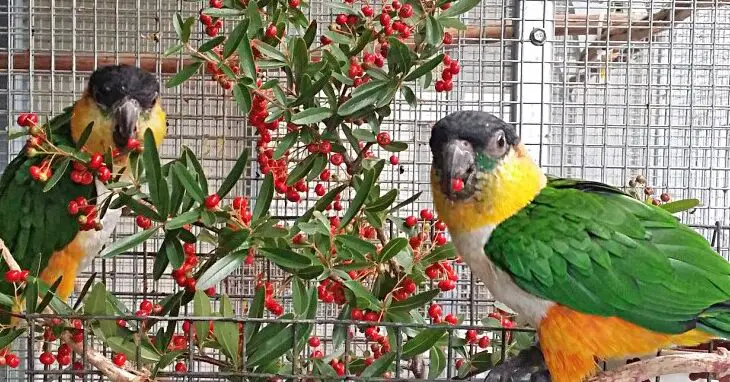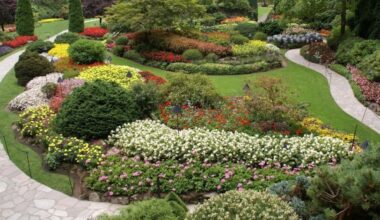To make an outdoor aviary look more natural, a little vegetation can be planted, in which the birds like to hide, roost and even build their nests. But care must be taken to ensure that the plants used are not dangerous or poisonous to them.
Animal welfare depends on many factors.
Wise planting gives animals landmarks for their territory and gives them a sense of security. In addition, plants attract all kinds of insects and produce fruit that animals enjoy.
Aviary birds love insects, fruits and seeds. Creating a suitable biotope is the guarantee for a lively and active aviary.
Contents
10 plants for an aviary
1. Everest Apple Tree
Its pink flowers turning to white give small tasteless yellow-orange apples tinged with red, 1 inch in diameter, very appreciated by birds and which hold on the tree a good part of the winter.
The quality and abundance of its pollen makes it an excellent pollinator for fruit trees.
It resists well to major diseases such as fire blight, apple scab and even powdery mildew.
Everest Malus – Self-fertile, attractive flowering and fruiting. Produces small apples that are very popular with birds. Attracts insects.
2. Aubert’s Knotweed
The Aubert’s knotweed (Fallopia aubertii) still called Chinese knotweed is a woody plant of the family Polygonaceae, sometimes cultivated as an ornamental plant, particularly adapted to cover medium-sized pergolas.
It is a very productive climbing plant that flowers until early winter.
3. Tiered vine ‘great star’
Viburnum plicatum ‘Mariesii’ Great Star is a pretty shrub, with a tabular growth habit and very attractive foliage in autumn. Important bloom which attracts insects. The edible fruits are a delight for birds.
4. Shrubby ‘Kobold’ Potentilla
Potentilla fruticosa ‘kobold’ is a small, upright, bushy, dense and nicely rounded shrub. Its small cut leaves are a pleasant light green. Between June and September, its cup-shaped flowers are a very bright lemon yellow. Very decorative by its long and abundant flowering, the potentilla ‘kobold’ is used in massif, group, isolated, rockery, border or can even be cultivated in vat.
It pleases insectivorous and granivorous birds.
5. The privet
It is Mr Goyaud who advised it to me (he only uses it in his aviaries). This bush can be cut and maintained easily. It grows quickly and is very easily pruned “in the shape of what we want”. The birds can easily build their nest inside and they eat the young shoots (tiny light green leaves). It can be decorative (depending on the shape you give it).
6. The hollyhock rose
It is a flower that forms a long stem. It blooms from July to October. The flowers attract insects … As the stems are vertical, it must participate in the maintenance of the nails of the birds that perch on them.
7. Bamboo
It is a plant which grows quickly and can be quickly bulky. In my opinion, it is necessary to prefer dwarf varieties (especially since bamboo does not cut itself or only at the foot). It also gives a tropical aspect to the aviary. Birds love it (especially the erythrurids). They eat the young shoots, use the old ones to line their nests and use them as a support to build their nests. In addition the vertical stems must also maintain the nails of the birds.
8. The hibiscus
This shrub has more than one asset, Obviously the flowers guarantee a decorative aspect not negligible (in addition to attracting insects). Moreover the flower resembles a little bit that of the hollyhock, but at the end of spring (before flowering), this shrub undergoes attacks of aphids.
Obviously outside the aviaries, it is necessary to treat… While inside, they will become the delight of the first young to be born (in May and June) In July the shrub will be completely cleaned naturally, by the parents (so much the worse for the following young).
The branches have a rather rigid aspect (this is often what is aesthetically reproached to this shrub). But they are solid perches and appreciated by the birds.
9. The laurel sauce
It is a relatively slow-growing shrub that is easy to maintain and prune. Birds appreciate it especially when it is dense (to build their nests). Its dark green permanent foliage gives a beautiful appearance in the aviary. And of course, its perfume can be appreciated.
10. The thuja
Like the privet its density will allow the birds to build their nest. Even if it is easy to size, it is necessary to follow it so that it does not invade the flight space. There are dwarf and very slow growing varieties…. On the taste side, birds like to suck the sap. In addition, flies and midges so sticky often. And thus become easy prey.
Summary
To make an outdoor aviary look more natural, a little vegetation can be planted, in which the birds like to hide, roost and even build their nests. But care must be taken to ensure that the plants used are not dangerous or poisonous to them. Here is a list of 10 non-toxic plants for your best friend.








